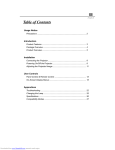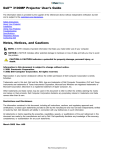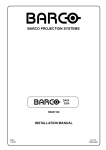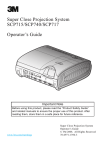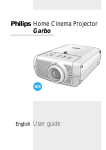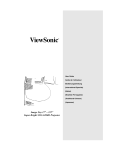Download Sagem CP 110-X User guide
Transcript
USER GUIDE CP 110-X SAGEM SA - Siège social : Le Ponant de Paris - 27, rue Leblanc - 75512 PARIS CEDEX 15 - FRANCE Société anonyme à directoire et conseil de surveillance au capital de € 36 044 360 - 562 082 909 R.C.S. PARIS © 2002 SAGEM SA. All rights reserved Reproduction is any manner whatsoever without the written permission of SAGEM SA is strictly forbidden. Informations in this document is subject to change without notice. Trademarks used in this user-guide: SAGEM and the SAGEM logo are trademarks of SAGEM SA ; Apple, Macintosh and PowerBook logo are trademarks of Apple Computer, Inc. ; Microsoft, Windows logo are trademarks of Microsoft Corporation ; DLP (Digital Light Processing), Texas Instruments logo are trademarks of Texas Instruments Corporation. Others trademarks and trade names may be used in this document to refer to either the entities claiming the marks and names or their products. SAGEM SA disclaims any proprietary interest in trademarks and trade names other than its own. 1 English Table of Contents Precautions for use Definitions ................................................................................... 2 Safety instructions ....................................................................... 2 Precautions........................................................................................... 3 Introduction Product Features .................................................................................. 4 Package Overview ............................................................................... 5 Product Overview ................................................................................. 6 Installation Connecting the Projector ...................................................................... 9 Powering On/Off the Projector ............................................................. 10 Adjusting the Projected Image ............................................................. 12 User Controls Panel Control & Remote Control .......................................................... 14 On-Screen Display Menus (OSD) ........................................................ 16 Appendices Troubleshooting .................................................................................... Changing the Lamp .............................................................................. Specifications ....................................................................................... Compatibility Modes ............................................................................. 23 26 27 28 2 English Precautions for use Definitions Warning- Risk of danger. Warning concerning the user and projector safety. Warning- Warning about the risk of electrics shocks. Warning- Warning about hot surface. Warning- Warning about the risk of lamp exposion. Safety instructions No user serviceable parts inside. The projector was operating at high voltage so never open the cabinet by yourself (except for changing the lamp). Please refer servicing to qualified personal. Warning Please do not open or disassemble the product as this may cause electric shock. To reduce the risk of fire or electric shock, do not expose this product to rain or moisture. Do not stare into the lens. The bright light may hurt your eyes. Warning To reduce the risk of injury to the eyes, do not look directly into the laser light on the remote control and do not point the laser light into anyone’s eyes. This remote control is equipped with a Class II laser that emits radiation. This product will detect the life of the lamp itself. Please be sure to change the lamp when it shows warning messages. When the lamp reaches the end of its life, it will burn out and may make a loud popping sound. If this happens, the projector will not turn back on until the lamp module has been replaced. To replace the lamp, follow the procedures listed under “Changing the Lamp” section (page 26). Warning When changing the lamp, please allow unit to cool down, and follow all changing instructions in “Changing the lamp” section (page 26). To avoid burns and bulb explosion while replacing the lamp, turn the projector off and unplug the power cord, wait at least 30 minutes before opening the lamp door. Please follow the instruction to replace the lamp in “Changing the lamp” section (page 26). After changing a new lamp, please reset the lamp life from OSD menu. Warning Before switching off the product, please keep the cooling fan running for a few minutes. When connecting the projector to the computer, please turn on the projector first. Warning To avoid damaging the projector, ensure that the zoom lens is fully retracted before moving the projector or placing the projector in its carrying case. Warning Only use the appropriate batteries, according the manufacturer specifications (see “Specifications” section in page 27). The provided batteries are not rechargeable. Bring back the defective or empty batteries to your local waste disposal in accordance with the current regulations. Do not throw of used batteries in the dustbin. 3 English Precautions Follow all warnings, precautions and maintenance as recommended in this user guide for your safety and also to maximize the life of your unit. Do: Disconnect the power cord of the product before cleaning. Clean the projector housing surface with a soft cloth slightly moistened with water. Do not use and type of solvent such as alcohol or benzene as it may mar the finish of the casing. Disconnect the power cord from AC outlet if the product is not being used for a long period of time. Since the projector is not equipped with a power supply on-off switch; the power supply cord is intented to save as the disconnect device. Don’t: Block the slots and openings on the unit provided for ventilation. Use abrasive cleaners, waxes or solvents for your cleaning. Use under the following conditions: - Extremely hot, cold or humid environment (see “Specifications” section in page 27). - In areas susceptible to excessive dust and dirt. - Near any appliance generating a strong magnetic field. - Place in direct sunlight. 4 English Introduction Product Features This product is an XGA single chip 0.7” DLP¥ Projector. The outstanding features of it are listed as follows: True XGA, 1024 x 768 addressable pixels 3.3 lbs (1.5 kg) lightweight compact design Single chip DLP¥ technology SXGA compression and VGA, SVGA re-sizing User replaceable lamp: model VIP R120/P16 rated 120W Mac/NEC PC-98/FM Towns compatible NTSC/NTSC4.43/PAL/PAL-M/PAL-N and HDTV (1080i,720P,480i/P) compatible Full function remote with mouse control and laser pointer High-tech DVI Connection for digital and analog video connectivity High definition TV compatibility User friendly Multilingual On-Screen Display menu (OSD) Advanced electronic keystone correction User friendly control panel with backlight Luxurious carrying case included 5 English Package Overview This projector comes with all the items shown below. Check to make sure your unit is complete. Contact your dealer immediately if anything is missing. Projector S-Video Cable DVI Signal Cable for HDTV/Component Battery x 2 Carrying Case Power Cord “Mini-Jack” Audio o 2 RCA plugs Remote Mouse Y Cable (USB or RS232) User Guide Scart Adaptor 3 RCA plugs D-Sub RGB to DVI Cable Video Cable Remote Control with Mouse Function & Laser Pointer Quick Start Card 6 English Product Overview Panel Control Temperature Warning LED Volume Mute Source Four Directional Select Keys Enter / Resync Menu (On/Off) Lamp Warning LED Power On / Standby Main Unit Elevator Button Panel Control Speaker Remote Control Receiver Manual Focus Ring Zoom Lens Power Connector Manual Zoom Ring Connection Ports Remote Mouse Input Connector Audio Input Connector HDTV/Component Video & Computer Input Connector S-video Input Connector Video Input Connector Output Monitor Loopthrough Connector 7 English Remote Control with Mouse Function & Laser Pointer LED indicator for a pressed key Multi-Directional disc selection Power / Standby Page Down Laser Pointer Resynchronisation Source Page Up Keystone Correction Volume ( + / - ) Mute Zoom In / Zoom Out Menu Freeze Caution: To reduce the risk of injury to the eyes, do not look directly into the laser light on the remote control and do not point the laser light into anyone’s eyes. This remote control is equipped with a Class II laser that emits radiation. Warning- Only use the appropriate batteries, according the manufacturer specifications (see “Specifications” section in page 27). The provided batteries are not rechargeable. Bring back the defective or empty batteries to your local waste disposal in accordance with the current regulations. Do not throw of used batteries in the dustbin. 8 English Close the cover of the remote control when you want to use the remote mouse. Do not forget to connect the remote mouse Y cable (USB or RS232). Cover Enter Key Laser Pointer Caution 9 English Installation Connecting the Projector Power Cord DVI Signal Cable for HDTV/Component Digital Port RGB Port DVI (VGA, XGA…) Output RS232 DVI D-Sub RGB to DVI Cable *DVI Signal Cable for DVI (VGA, XGA…) USB Remote Mouse Y Cable (USB or RS232) Cable of monitor Video Cable RCA Audio Cable “mini-jack” audio o 2 RCA plugs S-Video Output S-Video Cable D-Sub RGB to DVI Cable *DVI Signal Cable for DVI Video Output Audio Output c (*) DVI signal cable for DVI is an optional accessory. c To ensure the projector works well with your computer, please configure the display mode of your graphic card to make it less than or equal to 1024 X 768 resolution. Make sure timimg of the display mode is compatible with the projecor. Refer to the“Compatibility Modes”section on page 28. c HDTV: High Definition TV. c Scart adaptor o 3 RCA plugs: this adaptor is used to connect (by its scart plug) your TV set, your DVD player or your Video tape recorder (by its RCA plugs: 1 video and 2 audio). 10 English Power On/Off the Projector Powering On the Projector 1. Remove the lens cap.n 2. Ensure that the power cord and the video and/or computer cable are securely connected. 3. The “Power/Standby” indicator will flash.o And press the “Power/Standby” button to start on your projector. The startup screen will display and count down for 20 seconds and the Power/ Standby indicator will light solid amber. 4. Turn on your source (computer, notebook, or video player ,etc.): the projector will detect your source automatically. * If the screen displays “No Signal” , please make sure the signal cables are securely connected. * If you connect multiple sources at the same time, use the “Source” button on the Remote Control or Panel Control to switch. * Turn on the projector display first and then the computer. Power / Standby Lens cap 11 English Powering Off the Projector 1. Press the “Power/Standby” button to turn off the projector lamp. 2. After pressing the “Power/Standby” button, you will see a message “Power off the lamp?” on the On-Screen Display. Press the “Power/Standby” button again to confirm. Otherwise the message will disappear after 5 seconds. 3. “Power/Standby” LED indicator will flash amber for about 30 seconds. 4. Disconnect the power cord from the electrical outlet and the projector. * When the “LAMP” indicator lights solid orange; please change the lamp module immediately (see “Changing the lamp” section in page 26). * When the “TEMP” indicator lights solid orange, it indicates the projector has been overheated. The display will automatically shut itself down. Under normal conditions, the display can be switched on again for your presentation. If the problem persists, you should contact your local dealer or our service center on our Internet web site here bellow. * No matter the video source and/or computer is input or not, if you press“Power/ Standby”, a “Power off the lamp ?” sign will display in screen. You can clear the turn-off message by pressing any function key. Or you can just ignore this message without pressing any function key; the message will disappear after 5 seconds and restore to previous status. 12 English Adjusting the Projected Image Adjusting the Projector Height The projector is equipped with an elevator foot for adjusting the projector height. To raise the projector: 1. Press and hold the elevator button n. 2. Raise the projector to the desired display angle o, then release the button to lock the elevator foot into the required position. 3. Use the leveling knob p to fine-tune height adjustment. To lower the projector: 1. Press and hold the elevator button. 2. Lower down the projector, then release the button to lock the elevator foot into the required position. 3. Use the leveling knob p to fine-tune height adjustment. Elevator Button Elevator Foot Leveling knob 13 English Adjusting the Projector Zoom / Focus You may adjust zoom ring to zoom in / out. Rotate the zoom ring counter-clockwise to zoom in and clockwise to zoom out. To focus the image, rotate the focus ring until the image is clear. The projector will focus at distances from 3.3 feet to 39.4 feet (1m to 12m). Manual Zoom Ring Manual Focus Ring Adjusting Projection Image Size Max. Screen Min. (Diagonal) Max.(WxH) Screen Min.(WxH) Size Distance 25" 98" 123" 197" 246" 300" 20" 82" 102" 163" 204" 245" 20.0" x 15.0" 78.4" x 58.8" 98.4" x 73.8" 157.6" x 118.2" 196.8" x 147.6" 240.0" x 180.0" 16.0" x 12.0" 65.6" x 49.2" 81.6" x 61.2" 130.4" x 97.8" 3.3' 13.1' 16.4' 26.2' *This graph is for user’s reference only. 163.2" x 122.4" 196.0" x 147.0" 32.8' 39.4' 14 English User Controls Panel Control & Remote Control There are two ways for you to control the function: Remote Control and Panel Control. Panel Control (on the projector top cover) Remote Control Enter Key Power / Standby Refer to the “Power On/Off the Projector” sections on page 10~11. Source Press “Source” to choose RGB, Digital RGB, S-Video and Composite sources. Resynchronisation Use the Remote Control (R-Synch) Cover closed and remote mouse Y cable connected: this R-Synch key can be used as the mouse right click button. Cover open: this R-Synch key automatically synchronizes the projector to the input source. Use the Panel Control (RESYNC) Automatically synchronizes the projector to the input source, when you press this button while the OSD (On Screen Display) isn’t displayed. 15 English Four Directional Select Keys or multi-directional disc selection When you close the cover of remote control, this key can be used as a mouse to control direction. * The above function is only enabled with the connection between computer and projector by remote mouse Y cable. When the cover of remote control is open, this key can be used for the operation for OSD display (adjustments and navigations). PU: Page Up (Computer mode only) Use this button to page up. *Under remote mouse connected status c PageUp/Page Down: only with the remote mouse Y cable. only. PD: Page Down (Computer mode only) Use this button to page down. *Under remote mouse connected status only. Laser Point the remote control to the screen and hold the laser key to activate the laser beam. Menu Press “Menu” to open the On-Screen Display (OSD) menus and press keys to select main menu . To exit OSD, press the “ Menu” button again. The projector will save any changes you made automatically. Freeze Press the “Freeze” button to still the screen image. Mute Silences the speaker. Press again to activate the speaker. Volume + / Increases/decreases speaker volume. Keystone + / Adjust image distortion caused by tilting the projector. (± 16 degrees) Zoom In / Out (Computer mode only) Magnifies an image up to a factor of 20 times on the projection screen. Reduces the zoomed image. Enter Use the Remote Control (“Enter” key under the remote control) Confirm your selection of items, when you open the front cover of remote control. If the remote control cover is closed, the Enter button functions like the Left mouse button. Use the Panel Control (“Enter” key = ) Confirm your selection of items, when you press this button while the OSD is displayed. 16 English On-Screen Display Menus How to operate The Projector has a multilingual On-Screen Display(OSD) menus that allow you to make image adjustments and change a variety of settings. In computer source, the OSD will be the “Computer OSD”. In video source, the OSD will be the “ Video OSD”. The projector will detect the source automatically. To open the OSD menu, press the “Menu” button on the Remote Control or Panel Control. keys to select main menu. When OSD is displayed, press E.g.:Image-IJImage-IIJAudioJLanguageJManagementJImage-I... While making selection on a particular page, press “Enter” key to go into sub-menu. Press keys to select the required item and adjust the settings by keys. When a specified item is selected, the color of the item will change from yellowish brown to blue. E.g.:BrightnessJColor Temp.JZoomJContrastJKeystoneJBrightness... While using keys to adjust the parameter or required function in the items of the submenu, confirm all the functions of the main menu by pushing “Enter” button after all/part of the items have been modified. The screen will be back to the main menu at once. Only keys is enabled now. To exit the OSD, press the “Menu” button again. 17 English Computer mode Language Management Image-I Image-II Audio Brightness Zoom Contrast Keystone Color Temp. Image-I (Computer mode) Brightness Adjusting the brightness of the image. z Press the to darken the image. z Press the to lighten the image. Contrast The contrast controls the degree of difference between the lightest and darkest parts of the picture. Adjusting the contrast changes the amount of black and white in the image. z Press the to decrease the contrast. z Press the to increase the contrast. Color Temperature Adjust the color temperature. The range is from 6500K to 9000K . The factory default is 7050K . With the higher temperature, the screen looks colder; with the lower temperature, the screen looks warmer. Zoom z Press the to Magnify an image up to a factor of 20 times on the projection screen. z Press the to reduce the zoomed image. Keystone (Keystone Correction) Adjust image distortion caused by tilting the projector. (± 16 degrees) 18 English Video mode Language Management Image-I Image-II Audio Brightness Sharpness Contrast Tint Color Image-I (Video mode) Brightness Adjusting the brightness of the image. z Press the to darken the image. z Press the to lighten the image. Contrast The contrast controls the degree of difference between the lightest and darkest parts of the picture. Adjusting the contrast changes the amount of black and white in the image. z Press the to decrease the contrast. z Press the to increase the contrast. Color The color setting adjusts a video image from black and white to fully saturated color. z Press the to decrease the amount of color in the image. z Press the to increase the amount of color in the image. Sharpness Adjusting the sharpness of the image. z Press the to decrease the sharpness. z Press the to increase the sharpness. Tint The tint adjusts the color balance of red and green. zPress the to decrease the amount of green in the image. zPress the to increase the amount of red in the image. 19 English Computer mode Language Management Image-I Image-II Audio Frequency H. Position Tracking V. Position 16:9 / 4:3 Reset Yes No Image-II (Computer mode) Frequency “Frequency” is for changing the display data frequency to match the frequency of your computer’s graphic card. When you experience a vertical flickering bar, use this function to make an adjustment. Tracking Choose “ Tracking” item to synchronize the signal timing of the display with that of the graphic card. When you experience an unstable or flickering image, use this function to correct it. 16 : 9 / 4 : 3 You can select this function to fit your desired aspect ratio type: 16:9 = cinema, 4:3 = TV. Horizontal Position zPress the to move the image left. zPress the to mov e the image right. Vertical Position zPress the to move the image up. zPress the to move the image down. Reset Choose “ Yes” to return the display parameters of the current mode to its default settings (factory settings). * Reset items include both Image-I and Image-II settings. 20 English Video mode Language Management Image-I Image-II Audio Keystone Color Temp. 16:9 / 4:3 Reset Yes No Image-II (Video mode) Keystone Correction Adjust image distortion caused by tilting the projector. (± 16 degrees) 16 : 9 / 4 : 3 You can select this function to fit your desired aspect ratio type: 16:9 = cinema, 4:3 = TV. 4Color Temperature Adjust the color temperature. The range is from 6500K to 9000K . The factory default is 7050K . With the higher temperature, the screen looks colder; with the lower temperature, the screen looks warmer. 4Reset Choose “ Yes” to return the display parameters of the current mode to its default settings (factory settings). * Reset items include both Image-I and Image-II settings. 21 English Computer / Video mode Language Management Image-I Image-II Audio Volume Stereo / Mono Treble Mute Computer / Video mode Image-I Image-II Audio Language Management Bass Audio Volume zPress the to decrease the volume. zPress the to increase the volume. Treble The treble setting controls the higher frequencies of your audio source. zPress the to decrease the treble. zPress the to increase the treble. Bass The Bass setting controls the lower frequencies of your audio source. zPress the to decrease the bass. zPress the to increase the bass. Stereo / Mono zMono : Mono sound effect. zStereo : Stereo sound effect. Mute zChoose the left icon to make the volume function ineffective. zChoose the right icon to make the volume function effective. Language Language You can display the multilingual OSD menu . Use the language you prefer. The translation appears immediately. and keys to select the 22 English Computer / Video mode Image-I Image-II Audio Language Management Menu Location Lamp Reminder Projection Lamp Reset Signal Type RGB Component HDTV Management Menu Location Choose the Menu location on the display screen. Projection (Projection direction) z Front-Desktop The factory default setting. z Rear-Desktop When you select this function, the projector reverses the image so you can project behind a translucent screen. z Front-Ceiling When you select this function, the projector turns the image upside down for ceiling-mounted projection. z Rear-Ceiling When you select this function, the projector reverses and turns the image upside down at same time. You can project from behind a translucent screen with ceiling mounted projection. Signal Type Select signal type between RGB, HDTV and Component video sources: (HDTV = High Definition TV, RGB = VGA, XGA, SXGA, etc.). Lamp Reminder Choose this function to show or hide the warning message when the changing lamp message is displayed. The message will show up 36 hours before end of life. Lamp Reset Reset the lamp setting only when the new lamp is replaced. 23 English Appendices Troubleshooting If you are experiencing trouble with the projector, refer to the following. If the problem persists, please contact your local dealer or our service center on the Internet web site here below. Problem: No image appears on screen. Ensure all the video and/or computer cables and also the power supply cord are correctly and securely connected as described in the “Installation” section (page 9). Ensure the pins of connectors are not crooked or broken. Check if the projection lamp has been securely installed. Please refer to the “Changing the lamp” section (page 26). Make sure you have removed the lens cap and the projector is switched on. Problem: Partial, scrolling or incorrectly displayed image. Press the “R-Sync” button on the Remote Control or the “RESYNC” button on the control panel located on the projector top cover. If you are using a PC: If the resolution of your computer is higher than 1024 x 768. Follow the steps outlined below to reset the resolution. For Windows 3.x: 1. In the Windows Program Manager, click the “Windows Setup” icon in the Main group. 2. Verify that your display resolution setting is less than or equal to 1024 x 768. For Windows 95: 1. Open “My Computer” icon, the “Control Panel” folder, and then double click the “Display” icon. 2. Select the “Setting” tab. 3. In the “Desktop Area” you will find the resolution setting. Verify that the resolution setting is less than or equal to 1024 x 768 resolution. If the projector is still not projecting the whole image, you will need to also change the monitor display you are using. Refer to the following steps. 24 English 4. Follow above steps 1~2. Click on the “Advanced Properties ” button. 5. Select the “Change” button under the “Monitor” tab . 6. Click on “Show all devices”. Then select “Standard monitor types” under the “Manufactures” box; choose the resolution mode you need under the “Models” box. 7. Verify that the resolution setting of the monitor display is less than or equal to 1024 x 768. If you are using a Notebook PC: 1. You are required to implement above steps of resolution setting of computer first. 2. Switch the Notebook PC display to the “external display only” or “CRT only” mode. If you are experiencing difficulty in changing resolutions or your monitor freezes, restart all the equipment and the projector. Problem: The screen of the Notebook or PowerBook computer is not displaying your presentation. If you are using Notebook PC: Some Notebook PCs may deactivate their own computers’ screens when a second display device is in use. Each of them has different way to be reactivated. Refer to your computer’s documentation for detailed information. If you are using an Apple PowerBook: In Control Panels, open the PowerBook Display to select Video Mirroring “On”. Problem: Image is unstable or flickering Use “Tracking” to correct it (see page 19). Change the monitor color setting from your computer. Problem: Image has vertical flickering bar Use “Frequency” to make an adjustment (see page 19). Check and reconfigure the display mode of your graphic card to make it compatible with the product. Problem: Image is out of focus Adjust the Focus Ring on the projector lens. Make sure the projection screen is between the required distance 3.3ft.(1m)~ 39.4ft. (12m) from the projector. 25 English Problem : The screen is outstretched when displaying 16:9 DVD. The projector itself will automatically detect 16:9 DVD and adjust the aspect ratio by digitization to full screen with 4:3 default setting. If the projector is still outstretched, you will also need to adjust the aspect ratio by referring to the following: Please select 4:3 aspect ratio type on your DVD player if you are playing a 16:9 DVD. If you can not select 4:3 aspect ratio type on your DVD player, please select 4:3 in the “Image-II” menu of the projector. Problem: Image is reverse. To open “Menu” then selects “Management” to adjust the projection direction. Problem: Lamp burns out or makes a popping sound When the lamp reaches its end of life, it will burn out and may make a loud popping sound. If this happens, the projector will not turn back on until the lamp module has been replaced. To replace the lamp, follow the procedures in the “Changing the Lamp” (see page 26). 26 English Changing the lamp The projector will detect the lamp life itself. It will show you a warning message “ Lamp is running out of standard lifetime. Be sure to replace the lamp as soon as possible.” When you see this message, change the lamp as soon as possible. Make sure the projector has been cooled down for at least 30 minutes before changing the lamp. Warning: Lamp compartment is hot! Allow it to cool down before changing lamps! SAGEM may require that lamps replaced under warranty are returned to SAGEM. Otherwise, contact your local waste disposal agency for the address of the nearest deposit site. Lamp Changing Procedure: 1. Turn off the power to the projector by pressing the Power/Standby button. 2. Allow the projector to cool down at least 30 minutes. 3. Disconnect the power cord. 4. Use screwdriver to remove the screw from the cover (see n). 5. Remove the cover (see o). 6. Remove the 3 screws from the lamp module (see p). 7. Pull out the lamp module. o p Lamp module To replace the lamp module, reverse the previous steps. Warning: To reduce the risk of personal injury, do not drop the lamp module or touch the lamp bulb. The bulb may shatter and cause injury if it is dropped. CAUTION! DO NOT DEFEAT THIS INTERLOCK High temperature cool for at least 30 minutes. High pressure lamp may explode if improperly handled. Disconnect power before changing lamp. Replace only with OSRAM GmbH, MODEL VIP R120/P16 rated 120 W. n 27 English Specifications Light Valve - Single Chip DLPTM Technology Contrast Ratio - up to 500:1 (Full On / Full Off) Lamp - User replaceable lamp: model VIP R120/P16 rated 120W Number of Pixels - 1024 pixels(H) X 768 lines(V) Displayable Color - 16.7M colors Projection Lens - F2.2~2.4 f=28.51~34.21mm with 1.2 x zoom & focus Projection Screen Size - 20”~300” Diagonal Projection Distance - 3.3~39.4 ft (1m~12m) Video Compatibility - NTSC/NTSC 4.43/PAL/PAL-M/PAL-N and HDTV (1080i,720P,480i/P) compatible - Composite video & S-Video capability H. Frequency - 15kHz~100kHz horizontal scan V. Frequency - 43Hz~120Hz vertical refresh Multimedia Audio - One internal speaker with 2 watt output Power Supply - Universal 100~240V AC 50/60 Hz Power Consumption - 210 watts at normal operation Batteries for remote control - 1.5 V DC, LR03, type AAA (see inside the batteries compartment of the remote control). I/O Connectors - Power: AC Power Input Socket - Computer Input: One 30-pin DVI for analog/digital/component and HDTV signal - Computer Monitor Output: One 15-pin D-sub computer Monitor Output - Video Inputs: One Video RCA Input One S-Video Input - Audio Input: One “Mini-Jack” for Audio Input - Mouse Input : One 8-pin connector for remote mouse output (USB or RS232) Weight - 3.3 lbs. / 1.57 kg Dimensions (W x H x D) - 2.0 x 6.9 x 8.9 inches / 52 x 176 x 225 mm Environmental - Operating Temperature: Humidity: - Storage Temperature: Humidity: EMC regulations - EN 55022: 1998, Class B o o o o o o 10 C~ 40 C/50 F~104 F 80% maximum o o -20 C~60 C/ -4 F~140 F 80% maximum EN 55024:1998 EN 6100-3-2:1995+A1:1998 +A2:1998, Class A EN 61000-3-3:1995 Safety regulations - EN 60950:1992+A1:1993+A2:1993+A3:1995+A4:1997+A11:1997 28 English Compatibility Modes RGB (ANALOG) DVI (DIGITAL) Mode Resolution VESA VGA 640 X 350 70 31.5 70 31.5 VESA VGA 640 X 350 85 37.9 85 37.9 VESA VGA 640 X 400 70 31.5 70 31.5 VESA VGA 640 X 400 85 37.9 85 37.9 VESA VGA 640 X 480 60 31.5 60 31.5 VESA VGA 640 X 480 72 37.9 72 37.9 VESA VGA 640 X 480 75 37.5 75 37.5 VESA VGA 640 X 480 85 43.3 85 43.3 VESA VGA 720 X 400 70 31.5 70 31.5 VESA VGA 720 X 400 85 37.9 85 37.9 SVGA 800 X 600 56 35.2 56 35.2 SVGA 800 X 600 60 37.9 60 37.9 SVGA 800 X 600 72 48.1 72 48.1 SVGA 800 X 600 75 46.9 75 46.9 SVGA 800 X 600 85 53.7 85 53.7 VESA XGA 1024 X 768 43 35.5 43 35.5 VESA XGA 1024 X 768 60 48.4 60 48.4 VESA XGA 1024 X 768 70 56.5 70 56.5 VESA XGA 1024 X 768 75 60.0 75 60.0 VESA XGA 1024 X 768 85 68.7 - - * VESA SXGA 1280 X 1024 60 63.98 - - * VESA SXGA 1280 X 1024 75 79.98 - - MAC LC 13" 640 X 480 66.66 34.98 - - MAC II 13" 640 X 480 66.68 35 - - MAC 16" 832 X 624 74.55 49.725 - - MAC 19" 1024 X 768 75 60.24 - - * MAC 1152 X 870 75.06 68.68 - - MAC G4 640 X 480 60 31.35 - - MAC G4 640 X 480 120 68.03 - - MAC G4 1024 X 768 120 97.09 - - I MAC D V 640 X 480 117 60 - - I MAC D V 800 X 600 95 60 - - I MAC D V 1024 X 768 75 60 - - * I MAC D V 1280 X 1024 85 90.9 - - * I MAC D V 1280 X 960 75 75 - - NEC PC -98 SERIES 640 X 400 56.42 24.83 - - NEC PC -98 SERIES 640 X 480 70 31.5 - - NEC PC -98 SERIES 640 X 480 60 31.5 - - FUJTSU FM-TOWN 640 X 480 55.37 24.37 - - FUJSTSU FM-TOWN 640 X 480 60 31.5 - - * compression computer image. V.Frequency H.Frequency V.Frequency H.Frequency (Hz) (kHz) (Hz) (kHz)






























